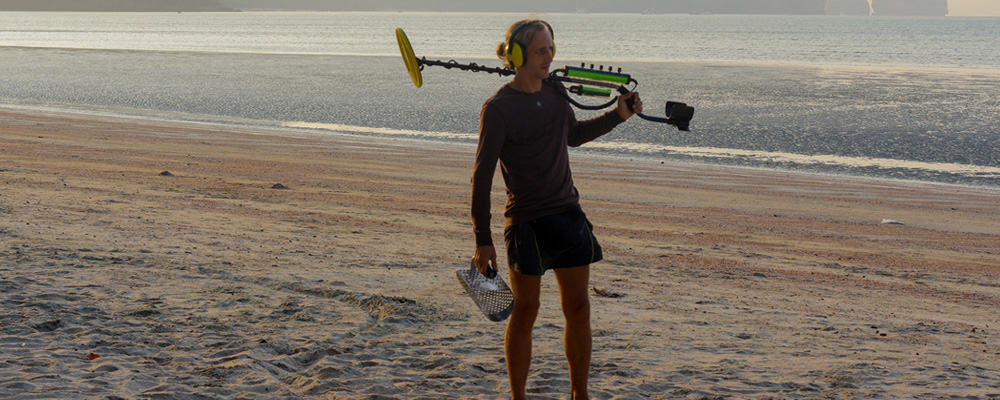One of the stereotypes of the hobby is an older man using a metal detector to search the beach for rings and coins. Though there’s much more to metal detecting than this stereotype, it does exist for a reason. Beach detecting can be a lot of fun and deliver higher monetary returns than land hunting in the right circumstances. Whether you’re just getting into metal detecting or you’ve already learned the ropes, this article will provide some useful advice to help you up your beach detecting game.
What can you find on the beach with a metal detector?
Beachgoers have lost all kinds of things over the years. The combination of sand, sunscreen, water, and swimming seem to create a perfect storm in which folks frequently lose coins, jewelry, and sunglasses (along with their pop cans, tent stakes, and fishing sinkers, it seems). In some areas, you can also make historic finds on the beach – some detectorists in the southeastern US have found items from Spanish shipwrecks, for example. But the most sought after and potentially lucrative finds on the beach are pieces of jewelry.
What is the best part of the beach to metal detect?
A beach is a big place. Where should you search? What areas are most likely to produce jewelry and other good finds? In terms of the natural features of a beach, there are three basic areas: dry sand, wet sand, and the waterline and beyond. Good finds can be made in all of these areas, but the most productive area will depend on the specific beach you’re hunting and the patterns of activity there. Does the beach swarm with thousands of people camped out with towels and umbrellas in the summer months? Do they hold events like weddings and concerts on the beach? Dry sand might be more productive in these circumstances. Searching a less crowded beach mainly for swimming might yield better results in the wet sand and waterline.
What is the best time to metal detect on the beach?
One of the challenging aspects of detecting the beach as compared to land is that the area that you’re searching is constantly changing due to tides and resulting erosion. This is compounded on some beaches by the addition or removal of sand (sometimes on a daily basis!) by the municipality managing the beach. To know how to read a beach, you have to understand one of the basic principles of beach detecting: deep sand is your enemy. Even the most advanced pulse induction metal detector won’t be able to find a desirable target that is “sanded in” and could be feet deep. So a part of reading the beach is looking for areas of erosion, also known as cuts.
Tides and erosion
Cuts occur naturally via tidal erosion and sand movement. They can range from a few inches in depth to dozens of feet in the most dramatic instances (these result from major storms). These are prime areas to detect for two reasons. Firstly, they’ve removed a significant amount of sand for you, getting your coil closer to the deep targets. Secondly, items lost on the beach will of course sink through the sand over time. How far they sink and the rate at which this occurs depends on the density of the metal. Generally speaking, most of the non-ferrous junk targets a detectorist digs are light materials like aluminum that will be washed out in big cuts, leaving behind the heavier, denser metals: silver, gold, copper, and platinum, along with a few others. So if you see beach erosion, that’s where you want to be.
This erosion is caused by tidal activity that is happening on a daily basis. But should a detectorist go at high or low tide? This will obviously depend on when you can go and how much time you have, but most would probably say that a low tide is preferable. Low tides can mean that some items lost in the water are now in the wet sand and can be found without wading in the water. Low tides also mean less sand between you and your target in many cases. But high tide has its advantages too – more people are at the beach losing are losing items during high tide and these tides can draw targets out and back towards the water. To time your detecting excursion, check out tidal information specific to your beach before heading off. This can generally be found for free online.
The other main aspect of reading a beach has to do with human activity. If possible, visit the beach at a busy time prior to when you detect or try to find photos of the beach during peak usage. This will tell you something about where people are swimming, where they are laying their towels and blankets, and where the concentrations of finds might be. In fact, beach detectorists will often refer to the “towel line”, the area of dry sand where beachgoers will post up when they aren’t swimming. Determining where that is along with other areas that people congregate will help you make the most of your detecting time.
Do you need permission to metal detect on a beach?
Typically not for public beaches. Many of the most frequented beaches are public property and do not require permission, though some states and municipalities will require detectorists to obtain a permit. Note that some government-owned beaches may be designated as historical sites and are off limits to metal detectorists. As for any beaches on private property, such as those owned by individuals or hotels, you would need to seek permission to metal detect. Fortunately for metal detectorists, the most high-traffic, target-dense beaches tend to be publicly owned.
What type of metal detector should I use on the beach?
Many metal detectors commonly used for other purposes struggle on saltwater beaches. Without going into all the reasons behind this, it will suffice to say that wet sand, black sand, and immersion in saltwater are challenging or impossible environments for detectors utilizing older technology, specifically single-frequency VLF (very low frequency) machines. Modern effective beach detectors tend to utilize either multi-frequency technology or pulse induction. These detectors have their advantages and disadvantages (for example, pulse induction machines are amazing underwater detectors but can’t discriminate as well as VLF or multi-frequency detectors) and they are fairly expensive. For a more detailed look at the best detectors to use for saltwater beaches, check out our guide to the best metal detectors for the beach.
For those who aren’t prepared to shell out for a multi-frequency or pulse induction detector, fear not. Freshwater beaches do not present the same technological challenges as saltwater sites. Popular swimming beaches on the lakeshore or similar can yield great jewelry and coins just like any saltwater beach and they require less upfront investment in your detector. On top of that, you don’t have to worry about saltwater if you’re sticking to the dry sand. There is gold, silver, and all sort of treasure to be found in the dry sand – you might just have to work a bit harder for it.
Beach metal detecting tools
Beach detecting requires a somewhat different set of tools relative to detecting on terra firma. Many detectorists, especially those detecting in the water, like to use a long handle sand scoop rather than a trowel or a shovel. A scoop will let the sand and small rocks fall through its grating, leaving your target for you to easily retrieve. As usual, having a pinpointer can be a big help as well. It is easy for small targets to evade you in the sand and that small target might just be a gold pendant or charm. One should also remember that the environment on the beach can be physically challenging. There is usually no shade, so sunscreen is a must in the summer months. Walking on sand for hours can make for sore feet and ankles and dehydration is a real danger. But if you plan your outing well, you’ll be retrieving targets with ease and avoid crisping yourself in the process. You’ll also want to carry a finds pouch and trash bag.
Is metal detecting on the beach worth it?
Most definitely! In fact, beach detectorists may ask themselves whether detecting inland is worth it. Popular beaches are rich in finds for the persevering and prepared detectorist. In particular, gold tends to be considerably more abundant on beaches than in parks, yards, or at old home sites. So get out there, get your coil over the sand, and if you need me, you can catch me on my shell.

